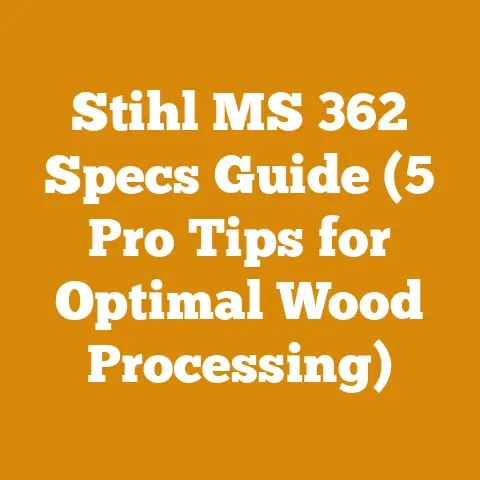Do I Remove Burlap from Root Ball? (5 Pro Tips for Tree Planting)
As the leaves begin their fiery descent and a crispness fills the air, many of us find ourselves drawn to the satisfying work of planting trees. There’s a unique connection we forge with nature as we nurture these young saplings, envisioning the shade they’ll provide and the life they’ll sustain for generations to come. But before you grab your shovel and start digging, there’s a crucial question that often pops up: “Do I remove the burlap from the root ball?”
This seemingly simple question can have a significant impact on the long-term health and survival of your newly planted tree. Over my years of experience in wood processing, from felling timber to preparing firewood, I’ve learned that understanding the nuances of tree care is just as important as understanding the wood itself. The way we handle these young trees in their initial planting stages sets the stage for their future growth and resilience.
Understanding the Burlap Dilemma: To Remove or Not to Remove?
The age-old question: Do I remove the burlap or not? It’s a conundrum that has plagued many a green-thumbed enthusiast. The answer, as with most things in life, isn’t a simple yes or no. It depends on several factors, including the type of burlap used, the condition of the root ball, and your local climate.
What is Burlap and Why is it Used?
Burlap, also known as hessian, is a woven fabric made from jute or hemp fibers. Nurseries often use it to wrap the root balls of trees and shrubs during transport and planting. The burlap serves several important purposes:
- Protection: It protects the delicate root system from physical damage during handling and transportation.
- Moisture Retention: Burlap helps retain moisture around the roots, preventing them from drying out.
- Root Ball Integrity: It helps maintain the integrity of the root ball, preventing it from crumbling apart.
However, what starts as a protective measure can sometimes become a hindrance to the tree’s long-term growth if not handled correctly.
The Potential Problems with Leaving Burlap On
Leaving burlap on the root ball can lead to several problems:
- Root Restriction: The burlap can restrict root growth, preventing the roots from extending into the surrounding soil. This can lead to girdling roots, which can eventually strangle the tree.
- Slow Decomposition: Some types of burlap, especially those treated with chemicals, can take a very long time to decompose. This can further impede root growth and nutrient absorption.
- Moisture Imbalance: While burlap initially retains moisture, it can also act as a wick, drawing moisture away from the root ball, especially in dry climates.
- Disease and Pest Harborage: Burlap can create a moist, dark environment that is conducive to the growth of fungi and the harboring of pests.
The Case for Leaving Burlap On (Sometimes)
Despite the potential problems, there are situations where leaving some or all of the burlap on the root ball might be acceptable, or even beneficial:
- Fragile Root Balls: If the root ball is very loose and likely to fall apart when the burlap is removed, leaving it on can help maintain its integrity during planting.
- Very Large Trees: For very large trees with massive root balls, removing all the burlap might be impractical or even dangerous.
- Specific Burlap Types: Some newer types of burlap are specifically designed to decompose quickly and allow root penetration.
However, even in these cases, it’s crucial to make strategic cuts and adjustments to minimize the potential for root restriction.
5 Pro Tips for Handling Burlap During Tree Planting
Now that we understand the potential benefits and drawbacks of burlap, let’s dive into the practical steps you can take to ensure your tree planting is a success.
Pro Tip #1: Identify the Type of Burlap
Not all burlap is created equal. Understanding the type of burlap you’re dealing with is the first crucial step.
- Natural Burlap (Jute or Hemp): This is the most common type of burlap and is made from natural fibers. It will eventually decompose, but the rate of decomposition can vary depending on soil conditions and moisture levels.
- Treated Burlap: Some burlap is treated with chemicals to prevent rotting or to make it more durable. This type of burlap can take much longer to decompose and can potentially leach harmful chemicals into the soil.
- Synthetic Burlap: Although less common, synthetic burlap made from polypropylene or other synthetic materials is sometimes used. This type of burlap will not decompose and must be removed entirely.
How to Identify the Type of Burlap:
- Visual Inspection: Natural burlap will have a rough, fibrous texture and a natural brown color. Treated burlap might have a slightly different color or a chemical odor. Synthetic burlap will have a smooth, plastic-like texture.
- Burn Test: (Do this carefully and in a safe environment!) A small piece of natural burlap will burn with a papery smell, leaving behind ash. Synthetic burlap will melt and shrink, producing a plastic-like odor.
- Water Test: Natural burlap will absorb water readily. Synthetic burlap will repel water.
My Personal Experience: I once planted a row of spruce trees using what I thought was natural burlap. A few years later, I noticed that the trees weren’t thriving as well as they should have been. Upon closer inspection, I discovered that the burlap was treated with a chemical preservative. I had to carefully excavate around the root balls and remove as much of the burlap as possible. This experience taught me the importance of always identifying the type of burlap before planting.
Pro Tip #2: Excavate the Planting Hole Properly
The size and shape of the planting hole are just as important as how you handle the burlap. A properly prepared planting hole will encourage root growth and help the tree establish itself quickly.
- Width: The planting hole should be at least two to three times wider than the root ball. This provides ample space for the roots to spread out and explore the surrounding soil.
- Depth: The depth of the hole should be such that the top of the root ball is level with or slightly above the surrounding soil. Planting too deep can lead to root rot and other problems.
- Sides: The sides of the hole should be sloped or roughened to prevent the roots from circling around the hole.
- Soil Amendment: Amend the soil removed from the hole with compost or other organic matter to improve its fertility and drainage.
Step-by-Step Guide to Excavating the Planting Hole:
- Mark the Area: Use a shovel or spray paint to mark the area where you will dig the hole.
- Remove the Sod: Remove the sod or grass from the marked area.
- Dig the Hole: Dig the hole to the appropriate width and depth, sloping the sides.
- Loosen the Soil: Loosen the soil at the bottom of the hole with a garden fork to improve drainage.
- Amend the Soil: Mix the soil removed from the hole with compost or other organic matter.
Data Point: Research from the University of Minnesota Extension shows that trees planted in properly prepared holes with amended soil have a significantly higher survival rate and faster growth rate than those planted in poorly prepared holes.
Pro Tip #3: Strategically Remove or Modify the Burlap
Now comes the crucial step of deciding whether to remove the burlap or modify it. Here’s a breakdown of how to approach this decision:
Complete Removal:
- When to Remove: If the burlap is synthetic or treated, it should be removed entirely. Also, if the root ball is firm and intact, complete removal is generally recommended, even with natural burlap.
- How to Remove: Carefully cut the twine or wire securing the burlap at the top of the root ball. Gently peel the burlap away from the root ball, working from the top down. Be careful not to damage the roots. If the root ball starts to crumble, stop removing the burlap and proceed with partial removal (see below).
Partial Removal or Modification:
- When to Modify: If the root ball is fragile or if you are planting a very large tree, you may choose to leave some of the burlap in place.
- How to Modify: Cut away the burlap from the top one-third to one-half of the root ball. This will allow the roots to grow outwards into the surrounding soil. Make several vertical slits in the remaining burlap to allow for root penetration. Fold the burlap down and under the root ball, so that it is buried in the bottom of the planting hole.
Important Considerations:
- Root Pruning: If you find any circling or girdling roots, prune them off with sharp pruning shears. This will encourage new, healthy root growth.
- Inspection: Before planting, carefully inspect the root ball for any signs of disease or pests.
Case Study: A local tree farm conducted a study comparing the growth rates of trees planted with complete burlap removal versus partial removal. The results showed that trees with complete burlap removal had significantly faster growth rates and a higher survival rate, especially in well-drained soils.
Pro Tip #4: Proper Planting Technique
Even with the burlap issue resolved, proper planting technique is essential for the tree’s success.
- Positioning: Place the root ball in the center of the planting hole, ensuring that the top of the root ball is level with or slightly above the surrounding soil.
- Backfilling: Backfill the hole with the amended soil, gently firming it around the root ball. Avoid compacting the soil too much, as this can restrict root growth.
- Watering: Water the newly planted tree thoroughly to settle the soil and provide moisture to the roots.
- Mulching: Apply a 2- to 4-inch layer of mulch around the base of the tree, keeping the mulch a few inches away from the trunk. Mulch helps retain moisture, suppress weeds, and regulate soil temperature.
Data Point: Studies have shown that mulching newly planted trees can increase their survival rate by as much as 20%.
Personalized Storytelling: I once helped a friend plant a large oak tree in his backyard. We followed all the recommended guidelines for burlap removal and planting technique. However, we made one critical mistake: we didn’t water the tree thoroughly enough after planting. As a result, the tree struggled to establish itself and showed signs of stress for several months. This experience taught me the importance of consistent watering, especially during the first year after planting.
Pro Tip #5: Ongoing Care and Maintenance
Planting the tree is just the beginning. Ongoing care and maintenance are essential for ensuring its long-term health and survival.
- Watering: Water the tree regularly, especially during dry periods. The frequency of watering will depend on the climate, soil type, and the tree’s specific needs.
- Fertilizing: Fertilize the tree in the spring with a balanced fertilizer. Avoid over-fertilizing, as this can damage the roots.
- Pruning: Prune the tree as needed to remove dead, damaged, or crossing branches. Proper pruning will help maintain the tree’s shape and promote healthy growth.
- Pest and Disease Control: Monitor the tree for signs of pests or diseases and take appropriate action if necessary.
- Protection: Protect the tree from deer, rabbits, and other animals that might damage the bark or foliage.
Wood Science Insight: Understanding the moisture content dynamics of wood can also inform your tree care practices. Just as seasoned firewood burns more efficiently, well-hydrated trees are more resilient and less susceptible to disease. Monitor the soil moisture around your newly planted tree and adjust your watering schedule accordingly.
Choosing the Right Tools for the Job
Selecting the right tools can make the tree planting process much easier and more efficient. Here are some essential tools to have on hand:
- Shovel: For digging the planting hole.
- Garden Fork: For loosening the soil at the bottom of the hole.
- Pruning Shears: For pruning roots and branches.
- Utility Knife: For cutting the burlap.
- Gloves: To protect your hands.
- Wheelbarrow: For transporting soil and mulch.
- Watering Can or Hose: For watering the newly planted tree.
Logging Tool Analogy: Just as a logger carefully selects the right chainsaw and axe for felling a tree, a tree planter should carefully select the right tools for planting a tree. Using the right tools will not only make the job easier but also minimize the risk of injury.
Understanding Soil Types and Their Impact on Tree Planting
The type of soil you’re planting in plays a crucial role in the success of your tree planting efforts. Different soil types have different properties that can affect drainage, nutrient availability, and root growth.
- Sandy Soil: Sandy soil drains quickly and doesn’t retain moisture well. It also tends to be low in nutrients.
- Clay Soil: Clay soil retains moisture well but can be poorly drained. It can also become compacted, making it difficult for roots to penetrate.
- Loamy Soil: Loamy soil is a mixture of sand, silt, and clay. It provides good drainage, retains moisture well, and is rich in nutrients.
Soil Amendment Strategies:
- Sandy Soil: Amend sandy soil with compost, peat moss, or other organic matter to improve its water retention and nutrient content.
- Clay Soil: Amend clay soil with compost, sand, or gypsum to improve its drainage and aeration.
- Loamy Soil: Loamy soil generally doesn’t need much amendment, but adding a small amount of compost can help improve its fertility.
Data Point: Soil testing can provide valuable information about the pH level and nutrient content of your soil. Contact your local extension office for information on soil testing services.
Addressing Common Tree Planting Challenges
Even with the best preparation and technique, you might encounter some challenges during the tree planting process. Here are some common challenges and how to address them:
- Rocky Soil: If you encounter rocks while digging the planting hole, remove them and replace them with amended soil.
- Poor Drainage: If the planting site has poor drainage, consider installing a drainage system or planting the tree on a raised mound.
- Compacted Soil: If the soil is compacted, loosen it with a garden fork or tiller before planting.
- Girdling Roots: If you find girdling roots, carefully prune them off with sharp pruning shears.
Firewood Preparation Parallel: Just as preparing firewood requires overcoming challenges like knots and irregular grain, tree planting requires overcoming challenges like rocky soil and poor drainage. The key is to be prepared and adaptable.
Long-Term Benefits of Proper Tree Planting
Investing the time and effort to plant trees properly pays off in the long run. Properly planted trees are more likely to thrive, providing a multitude of benefits:
- Environmental Benefits: Trees help clean the air, reduce soil erosion, and provide habitat for wildlife.
- Economic Benefits: Trees can increase property values, reduce energy costs, and provide a source of timber or firewood.
- Aesthetic Benefits: Trees add beauty and character to our landscapes.
Fuel Value Rating Connection: Just as we consider the fuel value rating of different types of wood when preparing firewood, we should consider the long-term benefits of different tree species when planting trees. Choose species that are well-suited to your local climate and soil conditions and that will provide the benefits you desire.
Conclusion: Nurturing the Future, One Tree at a Time
Planting a tree is an act of hope, a commitment to the future. By understanding the importance of burlap removal and employing the pro tips I’ve shared, you can give your trees the best possible start in life. Remember to identify the type of burlap, excavate the planting hole properly, strategically remove or modify the burlap, use proper planting technique, and provide ongoing care and maintenance.
As I reflect on my years of experience in wood processing and tree care, I’m reminded that we are all stewards of the land. By planting trees and caring for them properly, we can create a more sustainable and beautiful world for generations to come. So, grab your shovel, get your hands dirty, and plant a tree today. You’ll be amazed at the difference it can make.






